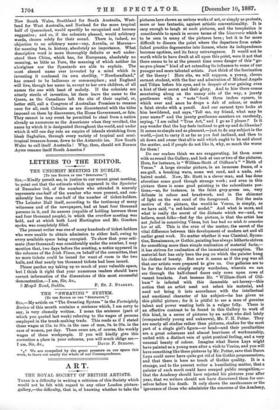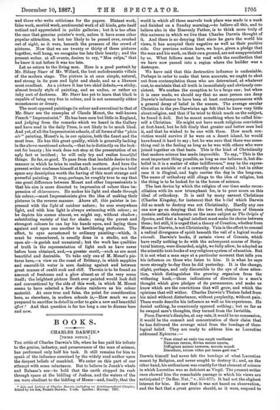ART.
THE ROYAL SOCIETY OF BRITISH ARTISTS. THERE is a difficulty in writing a criticism of this Society which would not be felt with regard to any other London picture- gallery,—the difficulty, that is, of knowing whether to take the pictures here shown as serious works of art, or simply as protests, more or less fantastic, against artistic conventionality. It is easy enough to laugh at such pictures, and the temptation is considerable to speak in severe terms of the biaarrerie which is to be seen in many of the pictures here ; but it is far more difficult to discern the point where the departure from estab- lished practice degenerates into license, where its independence becomes egotism, and its fancy extravagance. It would not be worth while to have dwelt at all upon this point, were it not that there seems to be at the present time some danger of this " go- es-you-please " kind of art extending its influence to some of our younger and more talented artists. Just think of the fascination of the theory ! Here sits, we will suppose, a young, clever, earnest student, with the fear and admiration of Michael Angelo and Titian before his eyes, and in despair of ever gaining even a hint of their secret and their glory. And to him there comes sauntering along on the sunny side of the way, a jaunty gentleman with a "note "-book three inches square, in which ever and anon he drops a dab of colour, or makes a faint stroke with a penoil. And our earnest tyro looks at• him bewildered, and says, 'Tell me, my friend, what may be your name?' and the jaunty gentleman saunters on carelessly, saying, 'I am called "True Art," and I go as I please !' Is it any wonder that the boy feels inclined to get up and do likewise? It seems so simple and so pleasant,—just to do any subject in the world,—jaSt to Carry it as far as you feel inclined, and then to sit down and swear that all is said which ought to be said about the matter, and if people do not like it why, so mach the worse for them !
Do our readers think we are exaggerating, let them come with us round the Gallery, and look at one or two of the pictures. Here, for instance, is "William-Sloth of Oldham's" "Birth of Venus." A large circular picture, in an immense frame, of a sea-gull, a breaking wave, some wet sand, and a nude, red. haired model. Now, Mr. Stott is a clever man, and has done aforetime some good though strange work ; and even in this picture there is some good painting in the subordinate por- tions,—as, for instance, in the faint grey-green sea, very delicate in colour and brushwork, and in the shimmer of light on the wet sand of the foreground. But the main motive of the picture, the would-be Venus, is simply, as we have said, "a red-haired model." And what is more, and what is really the secret of the distaste which we—and, we believe, most folks—feel for the picture, is that the artist has not failed in conceiving Venus, but has had no wish to conceive her at all. This is the crux of the matter, the secret of the vital difference between this development of modern art and all earlier great work. No matter whether it was Cline:limb Byzan- tine, Renaissance, or Gothic, painting has always hitherto striven for something more than simple realisation of material facts,— it has striven for realisation of the immaterial conception. The material fact has only been the peg on which the painter hung his clothes of beauty. But now it seems as if the peg was all that our artists were prepared to give us. Our galleries are to be for the future simply empty wardrobes, wherein we can see through the half-closed doors only rows upon rows of vacant brackets. just because Mr. "William-Stott of Old- ham" is infected with this damnable art-heresy—this notion that an artist need not select his material, and need not bring it into accordance with the intellectual and emotional character of his subject—he has given us this pitiful picture; for it is pitiful to see a man of genuine talent and power wasting both in a vulgar folly. There is an effective contrast to be found in this Gallery to work of this kind, in a series of pictures by an artist who died lately (comparatively young and unknown), Mr. F. H. Potter. They are nearly all stndies rather than pictures, studies for the most part of a single girl's figure—or head—and their peculiarities are a great soberness and almost heaviness of workmanship, united with a distinct vein of quiet poetical feeling, and a very unusual beauty of colour. Imagine what Baron Legs might have painted as a young man after a visit to Venice, and you will have something like these pictures by Mr. Potter, save that Baron Legs could never have quite got rid of his Gothic; prepossessions, and that there is here no touch of Gothic quality. It is a strange, and to the present writer a humiliating matter, that a painter of such merit could have escaped public recognition,— that the Academy should have rejected his pictures year after year, that we.writers should not have discovered them for our. selves before his death. It only shows the carelessness or the ignorance of those who administer the concerns of the Academy, and those who write criticisms for the papers. Blatant work, false work, morbid work, sentimental work of all kinds, gets itself noticed and appreciated in public galleries ; but it is too often the case that genuine painter's work, unless it have some other popular attraction, is but too likely to be passed over, crushed out of sight, as it were, beneath the pressure of the crowd of pictures. Now that we see twenty or thirty of these pictures together, well hung, we recognise too late their beauty; and the present writer, at all events, desires to cry, " Mea culpa," that he knew it not before it was too late.
Let us return to the living men. Here is a good portrait by Mr. Sidney Starr of Mr. Willard, the beat melodramatic villain of the modern stage. The picture is at once simple, natural, and strong in its pose and light and shade, and as a likeness most excellent. As a picture it has two chief defects,—a sticky, almost treacly style of painting, and an undue, or rather an inky sort of darkness. Mr. Starr has yet to learn that black is capable of being very fine in colour, and is not necessarily either monotonous or dreary.
The most opposed paintings (in colour and execution) to that of Mr. Starr are the examples of Claude Monet, the well-known French" Impressionist." He has been seen but little in England, and judging from the remarks which we heard in the Gallery and have read in the daily Press, is not likely to be much liked. And yet, of all the Impressionist schools, of all forms of the "plein air" painting, Monet's is, in our opinion, both the finest and the most true. He has this great quality, which is generally lacking in the above-mentioned schools,—that he is distinctly on the look- out for beauty ; his work does not stop at the presentation of an ugly fact or incident ; he will only try and realise beautiful things. So far, so good. To pass from that laudable desire to the manner in which he tries to realise such matters. And here the present writer confesses himself at fault ; he cannot give in a brief space any description worth the having of this most strange and powerfnl painting. It may, perhaps, be roughly true to say that one great difference between Monet and other Impressionists is that his aim is more directed to impression of colour than im- pression of chiaroscuro. He makes his light and shade through his colour,—most Impressionists give the idea of making their pictures in the reverse manner. Above all, this painter is im- pressed with the light of outdoor nature ; he sees everywhere light, and with him light is always swimming with colour ; so he depicts his scenes almost, we might say, without shadow ; substituting variety of tint for shade; using the purest and strongest colours be can lay his hands upon, and laying them against and upon one another in bewildering profusion. The effect, to eyes accustomed to ordinary painting—which, it must be remembered, is usually done in a studio, not the open air—is garish and unnatural ; but the work has qualities of truth in the representation of light such as have never before been obtained, and,—a greater merit,—such as are most beautiful and desirable. To take only one of M. Monet's pic- tures here,—a view on the coast of Brittany, in which sapphire and emerald-lit water is seen dashing against and between great masses of sunlit rock and cliff. Therein is to be found an amount of freshness and a glow almost as of the very scene itself; the brightest picture Brett ever painted would look dull and conventional by the side of this work, in which M. Monet seems to have selected a few choice rainbows as his colour material. At once true and false, the point for consideration here, as elsewhere, in modern schools is,---How much we are prepared to sacrifice in detail in order to gain a new and beautiful eject ? And that question is far too long a one to discuss here and now.























































 Previous page
Previous page